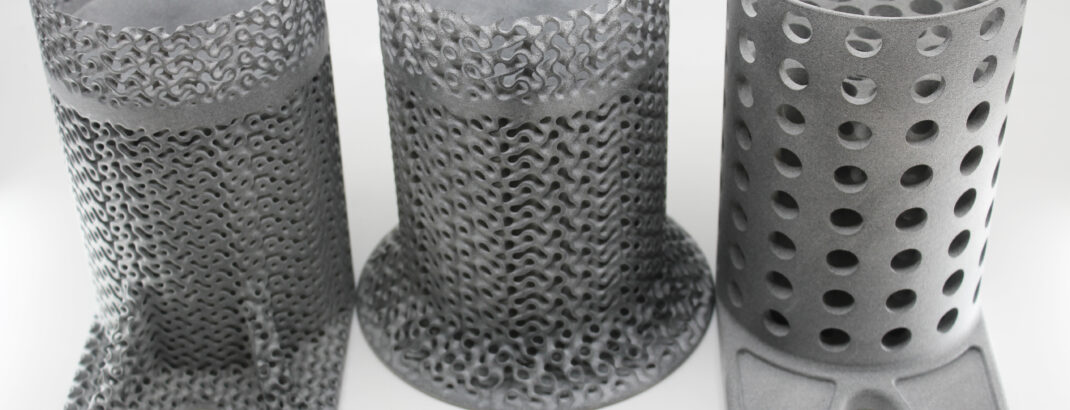Introduction
Measurement Solutions Limited (MSL) has rapidly become one of the most trusted UK partners for end-to-end ‘Design, Manufacture and Inspection’ solutions and is renowned for providing products and services to some of the UK’s leading automotive, aerospace, manufacturing, and educational organisations.
Application
Ricoh 3D sought the support of MSL, in relation to their expertise with the use of nTopology – the next-generation of engineering design software.
Ricoh 3D needed help to create a print-on-demand solution for a bespoke automation system, that a high-profile global food company required. Specifically, Ricoh 3D required an access kit: to create a complex part enabling heavy manufacturing equipment to be raised off the floor, in the form of ‘machine feet’.
“This was a great opportunity to showcase just what AM is capable of to a customer that would usually default to an overengineered design using subtractive manufacturing. We wanted to not only prove that AM is more than capable of performing in this environment, but also provide a truly unique part that would deliver over and above a conventionally manufactured component.”
Joe Winston, nTopology Account Manager, Measurement Solutions Ltd
Challenge
The challenge faced by Ricoh 3D in this instance was obtaining ‘buy-in’ from the customer. Most companies would often opt for bespoke fabricated steel. However, this can prove difficult in manufacturing timescales – having to consider business time-frame pressures to work to and resulting global impacts, in addition to incurring high expenses.
One challenge was convincing the customer that this alternative solution would work more effectively; swaying them away from symmetrical and over-engineered large steel works and convincing them that the solution would still have the performative ability to hold a machine of circa 500kg.
A new approach was adopted and, initially, the original designs were limited to conventional CAD modelling methods. This limitation meant that standard cuts and parametric modelling would typically generate an over engineered component.
The engineers at Ricoh 3D were familiar with optimisation and the ability to design components that perform to the specific application requirements, whilst also leading to organic and interesting shapes that are impossible to model via 3D CAD.
Having seen examples of optimised parts designed by MSL using nTopology, the engineers were inspired to adopt a new approach…
Solution
Optimising the Machine Feet in nTopology…
Joe Winston of MSL said: “Firstly, we imported the original part in to nTopology and used the inbuilt FEA to perform a static analysis. This showed us where areas of high stress were and proved out the fact that the part was massively overengineered. This not only created unnecessary weight, but also used material that wasn’t required in the manufacturing process.

“We used the shell feature in nTopology to create a variable wall thickness. By utilising the results of our static analysis, we were able to remove more material from low stress areas and remove less material in areas of high stress.

“At this point, we were happy with the overall geometry so decided to turn as much of the structure as we could in to a gyroid, removing even more material but maintaining a good level of structural rigidity.
“In nTopology we had complete control over the cell size and wall thickness. We used this to our advantage by again using our static analysis results to drive the gyroid structure. We created a geometry with thicker walls in high stress areas, and thinner walls in low stress areas. Not only did this optimise the gyroid structure, but it left us with a part that was visually stunning and a real talking point.


The lightweighted part(s) were manufactured as print-on-demand and assembled in a controlled environment at Ricoh UK Products Limited (RPL), the home of Ricoh 3D. Furthermore, this satisfied an initial consideration for freight costs as the machine feet needed shipping overseas to the end customer, so ‘lightweighting’ the final product was extremely beneficial.
Results
As part of this project, 12 machine feet were created. Adopting the nTopology software to optimise the machine feet meant they could safely account for the total weight of the machine at 500kg. The global customer requested that each foot be designed to withstand 60kg load – and the load capacity has been exceeded at a safety factor of 2 (120kg maximum load limit). Destructive testing was also undertaken in-house at Ricoh 3D to confirm the level of performance.
Testimonial
“This project goes to show that with the right mix of open-minded engineers, experts in the manufacturing process, and a software that can unlock previously unheard-of design solutions, there is scope to create some truly ground-breaking designs and a whole new way to think about designing AM components.
“As an industry, we need to encourage engineers to utilise every tool at their disposal to leverage all the benefits that AM can offer.”
Joe Winston, nTopology Account Manager, Measurement Solutions Ltd
